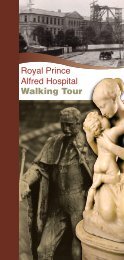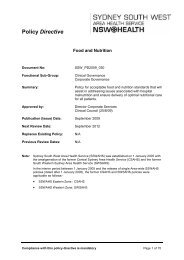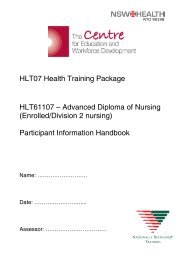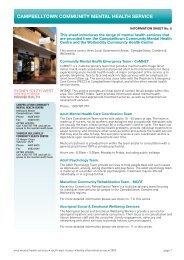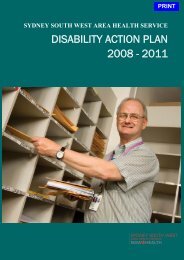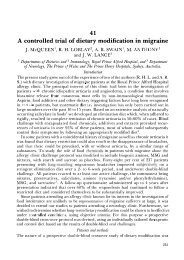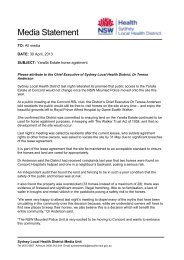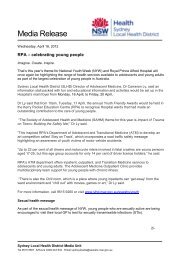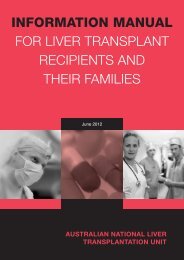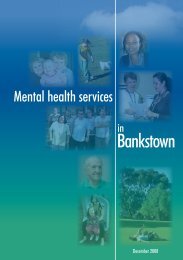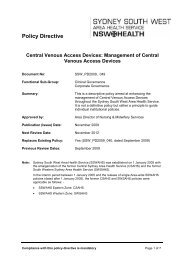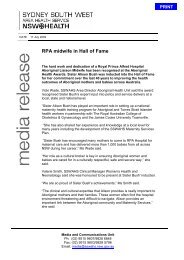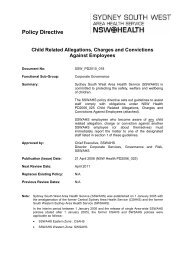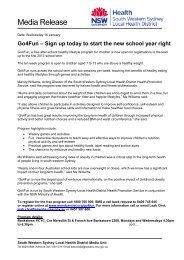<strong>Aged</strong> <strong>Care</strong> & <strong>Rehabilitation</strong> <strong>Clinical</strong> Service <strong>Plan</strong> <strong>2007</strong> - <strong>2012</strong>It is recognised that people from CALD communities with dementia are likely to revert to theirlanguage of birth as their dementia progresses. They will face greater problems in communication,resulting in further clinical management problems.There is little information on prevalence of dementia in Aboriginal and Torres Strait Islander peoplein Australia. However they may experience the physical and cognitive impacts of ageing at anearlier age. A NHMRC funded study into dementia and cognitive problems in urban indigenouscommunities is being undertaken. This study, which includes the SSWAHS communities, will seekto identify appropriate care models for Aboriginal people with dementia and cognitive problems.4.1.2 People with DeliriumDelirium is an acute, reversible organic brain disorder characterised by reduced ability to maintainattention to external stimuli and disorganised thinking as manifested by rambling, irrelevant orincoherent speech. The Australian Society of Geriatric Medicine (2005) reports the prevalence ratesof delirium on admission are 10% - 24% and that delirium develops in up to 56% of older people inhospital (climbing to 61% post operatively). All these patients require rapid assessment followed bythe development of management plans that involve minimising the risk of adverse events during theacute phase and supporting carers in maintaining their caring role post discharge4.1.3 People with Fall Related Injuries or at risk of Fall Related InjuriesOlder people (over 75 years) are known to have a higher incidence of fall related injury than theremainder of the population. Fall related injuries have a significant impact on the quality of life ofolder people and are a significant cost to the NSW Health system in terms of inpatient andresidential aged care beds, medical and allied health staff, and pharmaceuticals (NSW Health,2005b).NSW Health is projecting a considerable increase in the SSWAHS bed day demand for people aged75+ years, with an additional 17,923 bed days required between 2001 and 2016, an increase of44%. Falls related bed days are also projected to increase in the 60 -74 year age group, with anadditional 8,028 bed days required by 2016, an increase of a little more than two thirds (NSWDepartment of Health, 2005b). See Figure 4.2 following.Figure 4.2 Falls Related Bed Day Projections 2001 - 2016100,000Bed Days80,00060,00040,00020,00002001 2006 2011 20160-44 7,444 7,582 7,796 8,06145-59 4,655 5,287 5,738 6,18360-74 11,684 12,589 14,979 17,26975+ 40,183 46,706 51,696 58,106total 63,966 72,164 80,209 89,619YearSource: NSW Fall Injury Risk Indicators for SSWAHS 2001 – 2021 (2005)In 2001, 208 beds were required in SSWAHS to manage fall related injuries. This is projected toincrease by 38% to 288 beds in 2016 (assuming an occupancy rate of 85%). This equates to anadditional 80 beds.Page 26
<strong>Aged</strong> <strong>Care</strong> & <strong>Rehabilitation</strong> <strong>Clinical</strong> Service <strong>Plan</strong> <strong>2007</strong> - <strong>2012</strong>Closely linked with the issue of falls is the need to provide orthogeriatric support involvinggeriatricians and orthopaedic surgeons across acute, sub-acute and community settings.<strong>Rehabilitation</strong> specialists are also essential to the delivery of holistic care for patients with fall relatedinjuries.4.2 The <strong>Rehabilitation</strong> ClientThe Australasian Faculty of <strong>Rehabilitation</strong> Medicine (AFRM) of the Royal Australian College ofPhysicians (2005:2) defines rehabilitation medicine as “that part of the science of medicine involvedwith the prevention and reduction of functional loss, activity limitation and participation restrictionarising from impairments; and the management of that disability in physical, psychosocial andvocational dimensions”. A person may require rehabilitation for many reasons, such as the results ofinjury or trauma, chronic disease or another acute episode. The AFRM (2005) describes a client ofrehabilitation medicine as those people with a loss of function or ability due to injury or disease whocan reach the highest possible level of independence (physically, psychologically, socially andeconomically) through a combined and co-ordinated use of medical, nursing and allied healthprofessional skills.<strong>Rehabilitation</strong> services are provided to people of all ages, however this <strong>Plan</strong> will focus on the needsof adults (16+ years) requiring rehabilitation services. As with the aged care client, the rehabilitationclient can be categorised into various sub-groups. Those that are the major areas of workload, or ofplanned service development, are described below. However, it should be noted that there aremany other patients requiring rehabilitation services who are not described in the following sections.In addition to language and cultural barriers experienced by people from CALD communities, peoplewho have a refugee or refugee-like background may have experienced torture or trauma, or havedifferent perceptions and expectations of rehabilitation. This will impact on assessment andtreatment, and compliance with treatment.4.2.1 People who have had a StrokeAccording to Pollack & Disler (2002) stroke is the leading cause of chronic disability in adults inAustralia. Almost all patients require rehabilitation services after an acute episode of care for stroke(Pollack & Disler, 2002). For at least a year after the stroke occurs, people will, to varying degrees,require assistance with activities of daily living, with mobility and with managing a speechimpairment. Up to a quarter may also have an associated dementia or cognitive impairment, or adisabling anxiety or depression (SWSAHS, 1999).An analysis of hospitalisations due to stroke and transient ischemic attack (TIA) in SSWAHS overrecent years has shown a slight increase in the number of hospitalisations from 2,341 in 1999/2000to 2,352 in 2005/06 (FlowInfo 2005/06), with 74% of residents hospitalised for stroke or TIA in2005/06 were aged over 65 years.If, as expected, the incidence of stroke increases with the ageing of the population, this will result ina greater demand for rehabilitation services and an increased burden of disability in NSW (NSWDepartment of Health 2004c). <strong>Rehabilitation</strong> of these patients should commence in the acutesetting, with continued multi-disciplinary rehabilitation provided in either a sub-acute, community orhome based setting depending on individual circumstances.Geriatricians are also active in the provision of stroke rehabilitation services.4.2.2 People with a Chronic DiseasePeople with a chronic disease are projected to account for up to 80% of the health care burden by2020, with these people likely to have several co-morbidities (NSW Health 2005c). Chronicdiseases include respiratory problems, cardiovascular disease, diabetes and cancer.It is recognised that people with a chronic disease would benefit from integrated, multidisciplinaryrehabilitation services; however at present only a small proportion of people with a chronic diseasereceive the level and range of rehabilitation services which are likely to provide for the longest termbenefits to manage their disease. The provision of rehabilitation services for people with chronicdisease may result in greater health and psychosocial outcomes for the individual, reducedhospitalisations and length of stay, and reduced morbidity and mortality (NSW Health 2005c).Page 27



